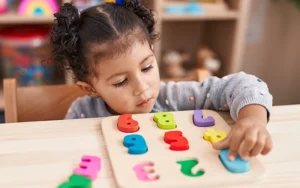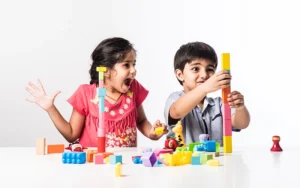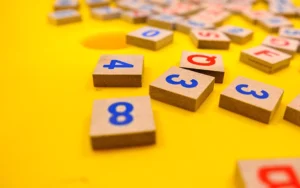Providing healthy meals for preschoolers is essential for their growth and development. A balanced diet fuels their body and mind, promoting energy, focus, and overall well-being. In this blog, we’ll explore the concept of solitary play and its importance in preschool development. We will cover the three main types of play solitary, parallel, and cooperative and discuss how solitary play benefits young children. By understanding these forms of play, you can encourage your preschooler’s independence, creativity, and focus.
What is Solitary Play?
Solitary play refers to a type of play where a child engages in an activity alone, without interaction with peers. This type of play is typical for younger preschoolers, typically between the ages of 2 and 3 who are still developing social and cognitive skills. Although solitary play may seem isolating, it is essential for children’s development and helps with focus, independence, and creativity.
While engaging in solitary play, children develop problem-solving skills, use their imagination, and begin to understand how to entertain themselves. This play style is crucial for building self-reliance, as it allows children to explore the world at their own pace without external influences.
The Three Types of Play: Solitary, Parallel, and Cooperative
While solitary play is an important stage, it is one of several types of play that preschoolers experience. Understanding the progression of play in children can help you better support your child’s social and emotional development.
1. Solitary Play
Solitary play occurs when a child plays alone. This play style is typically seen in younger preschoolers (around 2 to 3 years old) who are still developing social skills. During solitary play, the child may not engage with anyone else but is fully immersed in their own play experience. Examples of solitary play include:
- Building with blocks
- Playing with dolls or action figures
- Drawing or colouring
- Solving puzzles
Benefits of Solitary Play:
- Encourages independence: Solitary play teaches children how to entertain themselves, fostering a sense of self-reliance.
- Boosts creativity: Playing alone allows children to tap into their imagination and create their own world of stories and scenarios.
- Enhances concentration: When a child plays alone, they focus their attention on one activity, which can improve their ability to concentrate and problem-solve.
Solitary play is crucial in helping children learn to self-regulate, as it allows them to decide how to play without external influences. This leads to better decision-making and understanding of consequences.
2. Parallel Play
As children grow and begin to engage with their peers, parallel play emerges. This type of play occurs when children play beside each other but do not interact directly. While they may be playing with the same toys or engaging in similar activities, they do so independently.
Examples of parallel play:
- Two children are playing with building blocks side by side, but not collaborating.
- Preschoolers play with toy cars near each other, but without sharing or engaging in conversation.
Benefits of Parallel Play:
- Prepares children for social interaction: Although they aren't interacting directly, parallel play helps children learn how to share space and toys with others.
- Fosters observation skills: Children often observe each other during parallel play, picking up social cues and learning how to respond to others' actions.
Parallel play typically occurs in the developmental stage around 3 to 4 years old and marks an important transition toward more cooperative forms of play.
3. Cooperative Play
Cooperative play happens when children play together with a shared goal or purpose, collaborating on an activity. This type of play is the most advanced stage, and it involves interaction, communication, and teamwork.
Examples of cooperative play:
- Playing a team-based game like "Simon says."
- Collaborating to build a large structure with blocks.
- Working together on art projects like a large mural or a craft.
Benefits of Cooperative Play:
- Improves social skills: Children learn to communicate, share, and take turns during cooperative play.
- Builds teamwork: Preschoolers practice working as a team to accomplish a shared goal.
- Enhances problem-solving: Working together encourages group decision-making and critical thinking.
Cooperative play is typically seen in older preschoolers (around 4 to 5 years old) as they have developed the social and cognitive skills necessary to work well with others.
Benefits of Solitary Play for Preschoolers
While social play is crucial for development, solitary play offers numerous advantages that support cognitive, emotional, and social growth. Here are some of the key benefits of solitary play for preschoolers:
1. Enhances Cognitive Skills
During solitary play, children are in control of their own play activities. This freedom allows them to develop critical cognitive skills such as:
- Problem-solving: When children play alone, they encounter challenges that require them to think critically and figure out solutions on their own.
- Focus and attention: Solitary play encourages concentration, as children must maintain focus on their activity without distractions from peers.
2. Fosters Emotional Independence
Solitary play helps children learn to manage their emotions without relying on others. As they engage in solo activities, preschoolers experience moments of frustration, joy, and accomplishment, which all contribute to emotional growth. This helps them understand and regulate their feelings, promoting emotional maturity.
3. Boosts Imagination and Creativity
When children play alone, they have the freedom to create their own worlds and scenarios. This fosters imagination and creativity as they invent stories, characters, and play scenarios. Solitary play allows children to engage with their toys and activities in unique ways, expanding their creative thinking.
Types of Solitary Play Activities for Preschoolers
Now that we understand the benefits of solitary play, let’s explore some specific activities that can promote these developmental skills. Here are a few ideas for solitary play activities:
1. Building with Blocks
Building blocks are classic solitary play tools that promote creativity, problem-solving, and fine motor skills. Children can build structures, cities, or anything else their imagination desires. This activity encourages concentration and allows children to work through challenges on their own.
2. Drawing and Colouring
Art activities like drawing, coloring, and painting are excellent solitary play options. These activities help children express themselves creatively while also developing fine motor skills. As they focus on their artwork, children also practice patience and perseverance.
3. Puzzles and Games
Jigsaw puzzles, board games, or card games designed for solo play can help children with problem-solving, spatial awareness, and concentration. Solitary puzzle activities allow children to work through challenges without the pressure of competition.
4. Pretend Play with Dolls or Action Figures
Pretend play allows children to create stories and engage in imaginative scenarios. Using dolls, action figures, or stuffed animals, children can create their own adventures, strengthening their storytelling and creativity.
5. Sensory Play Activities
Sensory play activities like sand play, water play, or exploring different textures can be a great way for preschoolers to explore and learn independently. These activities help develop fine motor skills and sensory awareness.
How to Encourage Solitary Play in Preschoolers
While solitary play comes naturally to some children, others may need encouragement to engage in independent activities. Here are a few tips to foster solitary play in your preschooler:
1. Create a Dedicated Play Area
Set up a space in your home or classroom where children can engage in solitary activities. A quiet, well-organised area with toys, art supplies, and puzzles will encourage independent play.
2. Introduce New Toys Gradually
Introduce new toys or activities that promote solitary play, but avoid overwhelming your child with too many options at once. Start with one or two activities and gradually introduce new ones as your child becomes more comfortable playing alone.
3. Provide Quiet Time
Encourage quiet time during the day where your preschooler can engage in peaceful activities like reading, drawing, or solving puzzles. Quiet time helps children learn to enjoy their own company and practice independence.
4. Model Independent Play
Demonstrate how to engage in activities independently. For example, while your child plays, you can also read a book or engage in a quiet activity nearby. This model's independent behaviour and helps children understand that solitary play is a normal and valuable activity.
Conclusion: The Importance of Solitary Play in Preschool Development
Solitary play is an essential part of preschool development. It allows children to engage with the world on their terms, fostering independence, creativity, and cognitive skills. By understanding the types and benefits of solitary play, parents and educators can support preschoolers in developing these important skills. Encouraging solitary play alongside social play provides children with a well-rounded foundation for their overall development.
Want to know more about how play shapes your child’s development? Visit Rainbow Preschool to learn about our play-based curriculum and how we foster creativity, independence, and social growth in our students.
FAQs About Solitary Play for Preschoolers
1. What is meant by solitary play?
Solitary play refers to a type of play where a child engages in an activity alone, without interaction with peers. It is common in younger preschoolers and encourages independence and self-discovery.
2. What is the difference between solitary play and parallel play?
Solitary play is when children play alone without interacting with others, while parallel play occurs when children play side by side, engaging in similar activities, but not interacting directly. Parallel play often marks the transition from solitary to cooperative play.
3. What is an example of solitary activity?
Examples of solitary activities include building with blocks, colouring or drawing, solving puzzles, or engaging in pretend play with dolls or action figures.
4. What is solitude play?
Solitude play is another term for solitary play, where a child plays alone, often engaging with toys, games, or activities that require focus and concentration without interacting with other children.
5. What is solitary passive play?
Solitary passive play refers to activities where children engage in quiet, non-active forms of play, such as watching a book being read or listening to music. This form of play doesn’t involve physical activity but still encourages learning and development.
6. What is solitude in simple words?
Solitude refers to the state of being alone, and when used in play, it simply means a child is playing or engaging in activities independently, without interacting with others.







